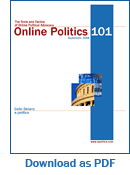Updated January, 2011

The internet really came of age as a fundraising tool in 2004 — the success of the Dean campaign and of groups like MoveOn.org startled most political professionals and observers, and other campaigns were quick to put new emphasis on the web and email lists as way to raise money from supporters. In 2007-2008 the Obama campaign raised online fundraising to a high art, and it became one of the most important contributors to his ultimate victory. The paragraphs below provide a good introduction to online fundraising, but for more details, definitely check out the fundraising chapters in Learning from Obama and Winning in 2010.
Of course, many groups and politicians do little but ask and ask and ask, and as I discussed in the section on list-building and list maintenance, that’s a quick way to burn out casual supporters and hard-core activists alike. What are some techniques to shake the most money out of those credit cards and Paypal accounts without poisoning the well for future requests?
Building relationships
As I talked about in the section on site promotion and audience-building, creating a sense of community and an emotional connection can be vital in the process of turning casual readers into dedicated supporters. If people feel a real attachment to your cause or candidate, they’re much more likely to want to help you out financially. Your goal is to build that connection and then use it in amounts carefully regulated to turn as few people off as possible.
You’ll reach your activists mainly through email (it remains absolutely the “killer app” of online fundraising), so think through your messaging strategy carefully. Some points to keep in mind:
- Carefully regulate your message frequency, which I discuss in some detail in the section on list management.
- Don’t just ask for money. If the only messages your supporters receive from you are fundraising attempts, you’re likely to lose them pretty quickly. Make sure that you’re sending them things THEY want, whether it’s issue updates, pretty pictures of animals, or chances to pester their elected officials, and not just an endless string of requests for money
- Whenever possible, tie a fundraising request to a specific action. Are you raising money to build schools in Africa? Talk about a particular community that would benefit and set a target. The DNC emails over the past couple of years or so have been very good about tying donations to specific state-party-building activities, and I can attest to their effectiveness (i.e., I’ve thrown them a few bucks).
- Plan for list exhaustion, and keep building your list. You’re constantly going to lose list members — no matter how good your issue, it’s going to happen. Build your list through every method you can.
Maximizing returns from your website
Besides raising funds through your existing supporters, you’ll want to maximize the money that you generate from casual visitors to your website (i.e., people who aren’t already receiving your emails). Putting a Donate button on every page is a no-brainer, but here are a few simple things you can do to get more out of it. They should also cross over to help you get more from your email outreach.
- Just as with emails, tie your ask to specifics about an issue. Try using different fundraising language on pages about different subjects. Get as detailed as you can about what the money will go for, assuming of course that it’s going for something that sounds good in print…and not just to administrative costs.
- Keep the number of steps in the donation process to a minimum. Web users are very sensitive to the details of sign-up processes — with every step, you’ll lose a few. Make it easy, for their benefit and yours.
- Suggest specific amounts for donations. According to a friend who’s been in the fundraising racket for years, suggesting amounts tends to make people more likely to give and to give more. A series of suggested donations with little checkboxes will do fine, as long as you leave one field blank for donations of other sizes. Don’t be afraid of large amounts! (As long as you also list smaller ones.)
- Pay close attention when you’re comparing vendors. Look at how much you’ll pay in a base amount per month for their system as well as the percentage they’ll take of every transaction. Run sample numbers for different vendors to get the best idea of which will work for you. And always test their systems for ease of use.
The Explosion of Online Fundraising
One fascinating development in the world of online fundraising has been its explosion during the 2008 election season, with Barack Obama and Hillary Clinton both raising tens of millions of dollars per month. In the 2010 cycle, politicians and interest groups alike continued the trend. Online fundraising has yielded several advantages, first by helping to build networks of small donors to whom a campaign can return again and again. Also, money raised online is available to the campaign immediately, while mailed checks can take days to arrive and be processed. Finally, online fundraising cuts the administrative costs of fundraising tremendously, both because checks no longer have to be entered and deposited and because donor information is immediately available for sorting into Federal Elections Commission and other regulatory reports.
And online fundraising isn’t just a game for presidential campaigns: sites like ActBlue on the left and Slatecard on the right are extending internet fundraising to candidates at all levels, while nonprofit advocacy groups have access to a broad array of tools to build supporter lists and plumb them for cash.
